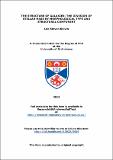Files in this item
The structure of galaxies : the division of stellar mass by morphological type and structural component
Item metadata
| dc.contributor.advisor | Driver, Simon | |
| dc.contributor.author | Kelvin, Lee Steven | |
| dc.coverage.spatial | 251 | en_US |
| dc.date.accessioned | 2013-06-13T10:53:44Z | |
| dc.date.available | 2013-06-13T10:53:44Z | |
| dc.date.issued | 2013-06-26 | |
| dc.identifier.uri | https://hdl.handle.net/10023/3689 | |
| dc.description.abstract | The mechanisms which cause galaxies to form and evolve each leave behind distinct structural markers in their wake. Dynamically hot processes (e.g., monolithic collapse, hierarchical merging) give rise to pressure-supported spheroidal structures, including elliptical galaxies and classical bulges. By contrast, dynamically cold processes (e.g., gas accretion, AGN splashback) lead to flattened rotationally-supported disk-like structures, often found on their own or as part of a spiral galaxy. If left in isolation for a sufficient length of time, secular evolutionary processes cause the formation of a bar-like structure within the disk, precipitating the genesis of a rotationally-supported pseudo-bulge. Robustly measuring galaxy structure enables us to ascertain the relative importance of these competing evolutionary mechanisms and; in so doing, help broaden our understanding of how the Universe around us came to be. This thesis explores the relation between galaxy structure, morphology and stellar mass. In the first part I present single-Sérsic two-dimensional model fits to 167,600 galaxies modelled independently in the ugrizYJHK bandpasses using reprocessed Sloan Digital Sky Survey Data Release Seven (SDSS DR7) and UKIRT Infrared Deep Sky Survey Large Area Survey (UKIDSS LAS) imaging data available via the Galaxy and Mass Assembly (GAMA) data base. In order to facilitate this study, we developed Structural Investigation of Galaxies via Model Analysis (SIGMA): an automated wrapper around several contemporary astronomy software packages. We confirm that variations in global structural measurements with wavelength arise due to the effects of dust attenuation and stellar population/metallicity gradients within galaxies. In the second part of this thesis we establish a volume-limited sample of 3,845 galaxies in the local Universe and visually classify these galaxies according to their morphological Hubble type. We find that single-Sérsic photometry accurately reproduces the morphology luminosity functions predicted in the literature. We employ multi-component Sérsic profiling to provide bulge-disk decompositions for this sample, allowing for the luminosity and stellar mass to be divided between the key structural components: spheroids and disks. Grouping the stellar mass in these structures by the evolutionary mechanisms that formed them, we find that hot-mode collapse, merger or otherwise turbulent mechanisms account for ~46% of the total stellar mass budget, cold-mode gas accretion and splashback mechanisms account for ~48% of the total stellar mass budget and secular evolutionary processes for ~6.5% of the total stellar mass budget in the local (z<0.06) Universe. | en_US |
| dc.language.iso | en | en_US |
| dc.publisher | University of St Andrews | |
| dc.relation | Kelvin L. S. et al., 2012, MNRAS, 421, 1007 | en_US |
| dc.subject | Astronomy | en_US |
| dc.subject | Extragalactic | en_US |
| dc.subject | Galaxy | en_US |
| dc.subject | Morphology | en_US |
| dc.subject | Structure | en_US |
| dc.subject | Sérsic | en_US |
| dc.subject | Profiling | en_US |
| dc.subject | Observational | en_US |
| dc.subject | Catalogues | en_US |
| dc.subject | Galaxies | en_US |
| dc.subject.lcc | QB857.K4 | |
| dc.subject.lcsh | Galaxies--Classification | en_US |
| dc.subject.lcsh | Stars--Masses | en_US |
| dc.title | The structure of galaxies : the division of stellar mass by morphological type and structural component | en_US |
| dc.type | Thesis | en_US |
| dc.type.qualificationlevel | Doctoral | en_US |
| dc.type.qualificationname | PhD Doctor of Philosophy | en_US |
| dc.publisher.institution | The University of St Andrews | en_US |
This item appears in the following Collection(s)
Items in the St Andrews Research Repository are protected by copyright, with all rights reserved, unless otherwise indicated.

